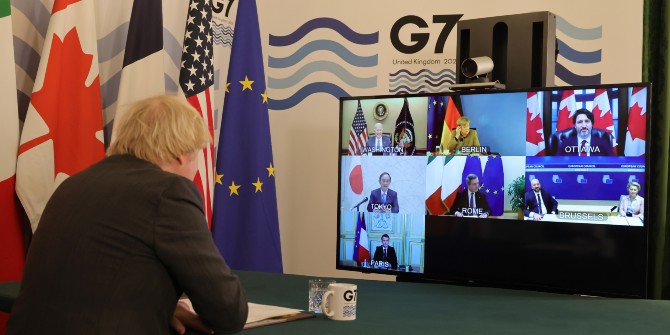The COVID-19 pandemic has been a significant shock for the global economy. With nations protecting their borders and even limiting some trade, does globalisation now face an existential threat? In reality, this is not an entirely new issue, write Michael Cox, Peter Watkins, and Linda Yueh (LSE Ideas). However, COVID-19 could accelerate the rebalancing of supply chains from global to more regionally- or locally-based ones, they argue, not least as states start to adopt a broader conception of national security.
The Financial Crisis of 2008 stress-tested globalisation and there have been growing signs of fragmentation, not least as a result of the sharper competition in trade and other domains between the United States and China (and the accompanying political rhetoric). But the pandemic appears to be intensifying these trends – and raising profound questions about the effectiveness of the multilateral bodies which have provided the international institutional framework for globalisation (including the United Nations and the World Trade Organisation). As we begin to contemplate a “new normal” beyond (at least the first wave of) the pandemic, this blog discusses its potential impact on global supply chains – the sinews of globalisation – from an economic and a security perspective.
Open economies depend on the cross-border flow of goods and services as well as on capital flows to sustain investment. These trade and investment flows also affect the procurement decisions of public authorities and private corporations. Globalised supply chains have increasingly facilitated these transactions and decisions, i.e., goods could come from wherever they could be manufactured relatively efficiently (and cheaply), transported to their customers on a “just-in-time” basis by container ships or air cargo, with businesspeople flying around the world to sew up the underpinning deals. A pandemic makes all that more difficult.

But the globalisation of supply chains had been changing before the Coronavirus pandemic took hold. There was already an emerging trend towards a rebalancing in favour of more regionalised or localised supply chains – for technological, geo-economic and other reasons. The main technological reason has been the spread of additive manufacturing or 3D printing. This makes it economically viable to produce small volumes of parts locally rather than import them even via just-in-time systems. Some industry analysts even say that the majority of civil airliners in service today have at least one 3D-printed component. And there have been broader factors which have accelerated the trend. First, environmental: the “climate emergency” has made consumers increasingly uncomfortable about the impact of transporting huge volumes of goods and people long distances. Secondly, social: globalisation inevitably creates “losers” and those who feel “left behind” have become increasingly vocal about production having been offshored. Thirdly, the US-China trade war and Brexit had led to uncertainty about potential disruptions to cross-border supply chains through both tariffs and investment restrictions.
The pandemic adds complexity – not least through its impact on public procurement, with global supply chains struggling to meet demand from governments for now politically sensitive items, such as personal protective equipment for medical staff. But it appears to be accelerating an existing trend towards a rebalancing of the global supply chains towards being more local or regional rather than starting a new one.
Does a similar observation apply when looking at these issues from a security perspective?
Over-simplifying and generalising a little, until relatively recently, Western governments – including their defence and national security communities – did not worry that much about supply chains other than in certain specialised areas. There was an assumption that governments could get most of what they wanted from the market – it was the selected prime contractor’s responsibility to manage the supply chains and governments had relatively little visibility of them below the higher tiers.
But this began to change around five years ago, with the recognition – particularly after the Russian intervention in Ukraine – that state-on-state competition was back and in a different form: “hybrid” or “grey zone” conflict. Defence and security supply chains were in this conflict zone. Key suppliers could be subject to disinformation and cyber-attacks – or simply purchased by investment vehicles linked to other governments with other agendas. The UK government has already obtained some limited additional legal powers and has published a White Paper setting out further potential measures with respect to foreign investments in certain sectors of the UK economy. Other Western governments have also been reviewing their powers.
The COVID-19 pandemic will reinforce this loss of innocence about globalised supply chains – especially as it will almost certainly lead to a broader conception of national security, with greater emphasis on societal resilience. What were once seen as mainly economic or technical decisions about the sourcing of components and “dual-use” (military and civilian) items will become more political. The UK government (like other Western governments) will need to review and monitor more closely the supply chains that underpin our national security capabilities in this wider sense (e.g. key telecommunications, energy and medical equipment as well as security and defence systems). This will enable more informed decisions about supply chain risks, including which critical components should be sourced only from the UK or from close allies/partners – and which companies in these supply chains should remain in national ownership.
One challenge ahead will be to develop clear criteria for these decisions – preferably, in consultation with allies and partners. Such clarity would provide greater consistency in decision-making, greater certainty for investors – and build greater awareness in the private sector of national security considerations in an increasingly dangerous world.
In conclusion, economic drivers including technology, geo-economics, etc coupled with growing security concerns will contribute to pre-existing trends. The COVID-19 pandemic could accelerate these trends toward re-balancing supply chains between global and more local suppliers and distributors. The challenge here will be to re-balance in a way that preserves the openness to commercial trade and investment with the re-thinking of policies around security, geo-economic concerns as well as managing environmental and technological change.
This post represents the views of the authors and not those of the COVID-19 blog or LSE. Image: Public Domain Dedication (CC0).





